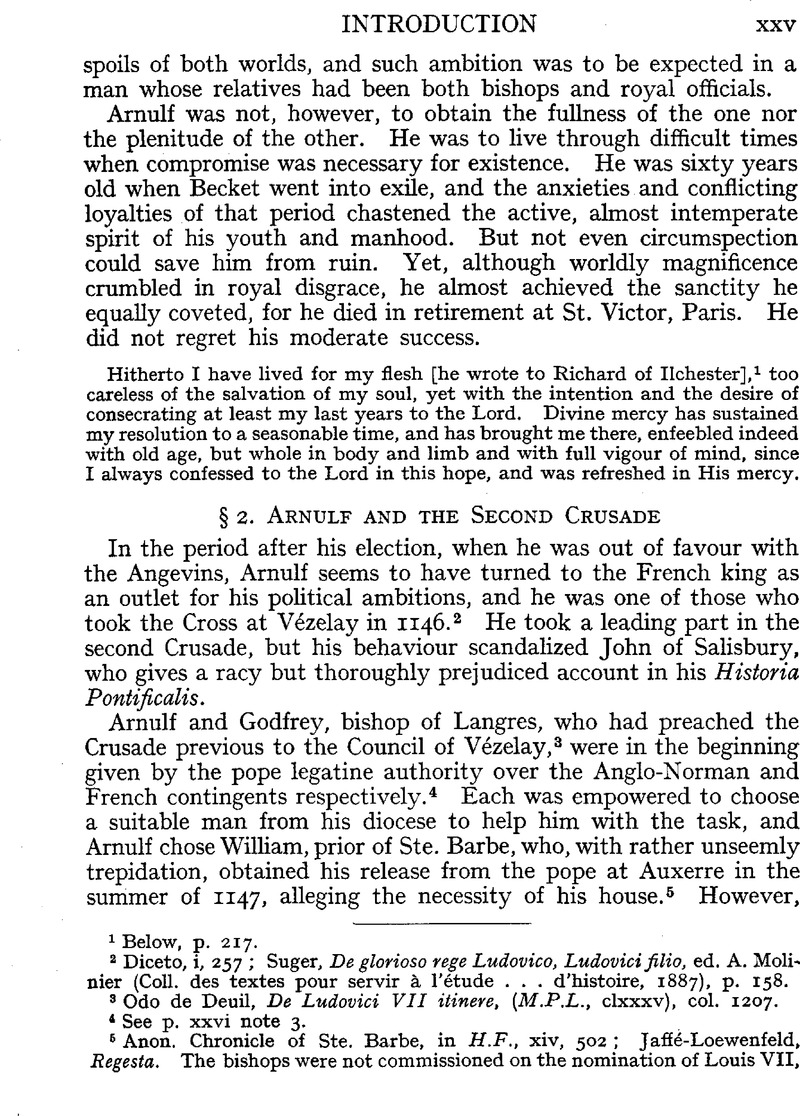No CrossRef data available.
Article contents
§2. Arnulf and the Second Crusade
Published online by Cambridge University Press: 24 December 2009
Abstract

- Type
- Introduction
- Information
- Copyright
- Copyright © Royal Historical Society 1939
References
page xxv note 2 Diceto, , i, 257Google Scholar; Suger, De glorioso rege Ludovico, Ludovici filio, ed. A. Molinier (Coll. des textes pour servir à l'étude … d'histoire, 1887), p. 158.Google Scholar
page xxv note 3 Odo de Deuil, De Ludovici VII itinere, (M.P.L., clxxxv), col. 1207.
page xxv note 4 See p. xxvi note 3.
page xxv note 6 Anon. Chronicle of Ste. Barbe, in H.F., xiv, 502Google Scholar; Jaffé-Loewenfeld, Regesta. The bishops were not commissioned on the nomination of Louis VII, and the deputies mentioned were for the Crusade and not for the diocese, as the next paragraph in the chronicle shows.
page xxvi note 1 Anon. Chronicle of Ste. Barbe, loc. cit.; document printed by Haskins, Norman Institutions, p. 322.Google Scholar
page xxvi note 2 Odo, op. cit., col. 1210.
page xxvi note 3 John gives the bishops no official standing. The chronicle of the monastery of Ste. Barbe in the diocese of Lisieux (col. 502) states explicitly that Arnulf and Godfrey were given legatine authority by the pope, and Odo de Deuil (op. cit., passim), while mentioning the activities of these two bishops has no reference to the cardinals. On the other hand, William of Tyre (Hist. Rer. in Part. Trans. Gest., (M.P.L., cci.) cap. xvii, 1) supports John of Salisbury in his naming of one of the genuine legates, but even he gives the names of Arnulf and Godfrey before that of Guy. The only reference that Arnulf makes to his Crusading adventure, is that he went unwillingly by the pope's order (below, p. 210); but this was written much later, and was part of a piece of special pleading.
page xxvi note 4 Hist. Pont., pp. 55–6.Google Scholar
page xxvi note 5 See above, p. xxi, n. 5.
page xxvii note 1 Op. cit., p. 56; see above, p. xxii, n. 7. Godfrey was held a saint in his order (Henriquez, C., Menologium Cistertiense (Antwerp, 1630), p. 237).Google Scholar
page xxvii note 2 Odo, op. cit., col. 1223.
page xxvii note 3 William of Tyre, Historia (M.P.L., vol. cci), xvii, 1.
page xxvii note 4 He supported Theodoric, count of Flanders, who was in favour of a short campaign. Godfrey opposed these counsels. See John of Salisbury, op. cit., P. 56.
page xxvii note 5 Arnulf is found in Normandy in 1148 (Léchaudé d'Anisy, Les Anciennes Abbayes de Normandie (1834), i, 94).Google Scholar
page xxvii note 6 Letters in H.F., xv, 500 and 501.Google Scholar




